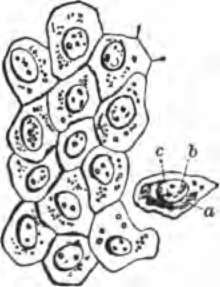Chapter II. The Microscopical And Chemical Composition Of The Body
Description
This section is from the book "The Human Body: An Elementary Text-Book Of Anatomy, Physiology, And Hygiene", by H. Newell Martin. Also available from Amazon: The Human Body.
Chapter II. The Microscopical And Chemical Composition Of The Body
What The Tissues Are Like
Haying gained some idea of how the larger parts of the body are arranged we may next inquire what the tissues, its smallest parts which are combined to make the larger, are like. The simplest tissues are known as cells; * they are 60 small that a separated cell can only be seen with the help of a microscope. In a fully formed cell (Fig. 5) we find three parts: (1) a cell body made up of a soft granular substance; (2) a smaller and less granular cell nucleus imbedded in the cell body; and (3) a tiny dot, the nucleolus, lying in the nucleus. Cells vary much in form and size, though all are very small. A good many, like those represented at b, float in our blood, and are more or less rounded. In other places cells are flattened to form thin scales as those in Fig. 6, which represents cells scraped from the inside of the wall of the abdomen. Elsewhere we find cells elongated, as c, Fig. 5; if this goes on to any great extent we get a long slender thread which is called a fiber; but very often fibers are made by a number of cells, all elongating a little and then joining together end to end. Examples of fibers are shown in Figs. 35 and 85. Speaking in general terms, we may say that the whole body consists of tiny cells, either rounded and thick, flat and thin, or elongated to form fibers. Just as a wall is built of distinct bricks or stones, so an organ is made up of a number of cells. All the solid parts of the body are either cells or fibers which have grown from cells, except something which corresponds pretty closely to the mortar which lies between the bricks of a wall and holds them together. This latter material, known in the body as intercellular substance, is in some places abundant, in others scanty or absent.
Of what are the larger parts of the body made up? What are the simplest tissues ? What instrument must we employ in order to see them ? Describe the structure of a cell. Describe some different forms of cells.

Fig. 5. Forma of cells from the body.
* So called from an old belief that they were little bags or chambers. Most cells are really solid or semi-solid throughout.
Wherever found, the intercellular substance is made by the cells which lie imbedded in it; they pass it out from their surfaces and repair it when necessary, and in this respect it differs very essentially from the mortar which a mason lays between his bricks.
Summary
Cells are thus at bottom the things which make up the body and do its work; their forms and the way they are arranged together determine the form of the organs; the things which the kinds of cells found in it can do, determine the faculties of each organ. Some cells can make a great deal of hard intercellular substance, and are employed to construct the skeleton ; others can change their shape and are used to form the organs which move the body; others can elaborate peculiar solvent liquids and are used in the organs of digestion ; and so on through all the parts. Anatomy in the long run is a study of the forms which cells and intercellular substances may assume ; and physiology a study of what the cells and intercellular substances of the body can do.

Fig. 6. Flat cells from the surface of the lining membrane of the abdomen; a, cell body; 6, nucleus; c, nucleoli.
What are fibers ? How are they made ? In what respect may an organ be compared to a brick wall ? What corresponds to the mortar of the wall ? What makes the intercellular substance ? How ?
State briefly the relationship of its cells to the structure and working of the body.
Continue to:
